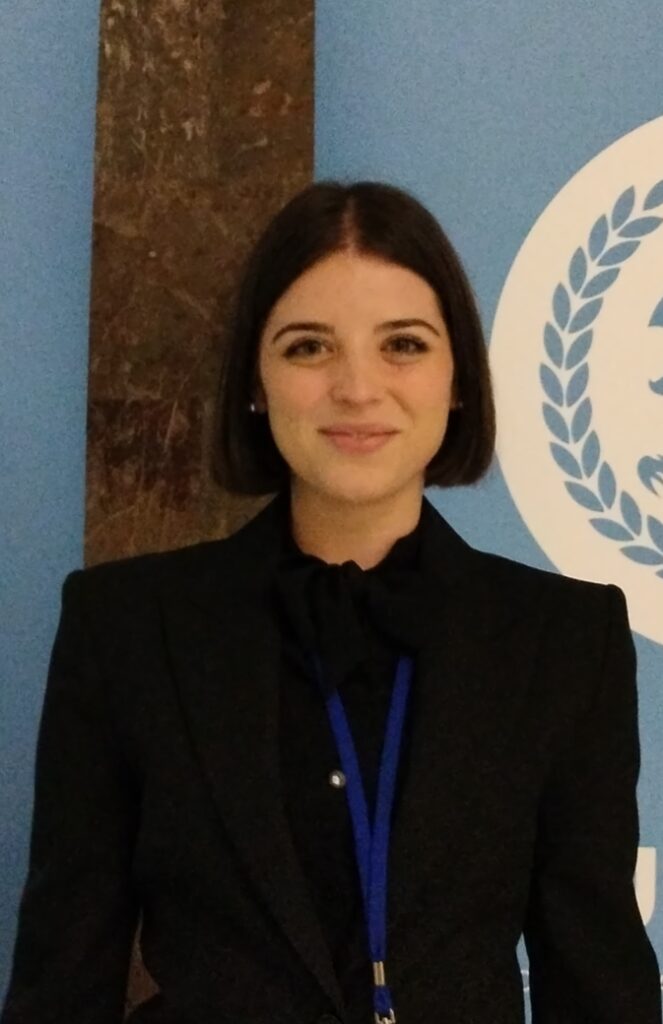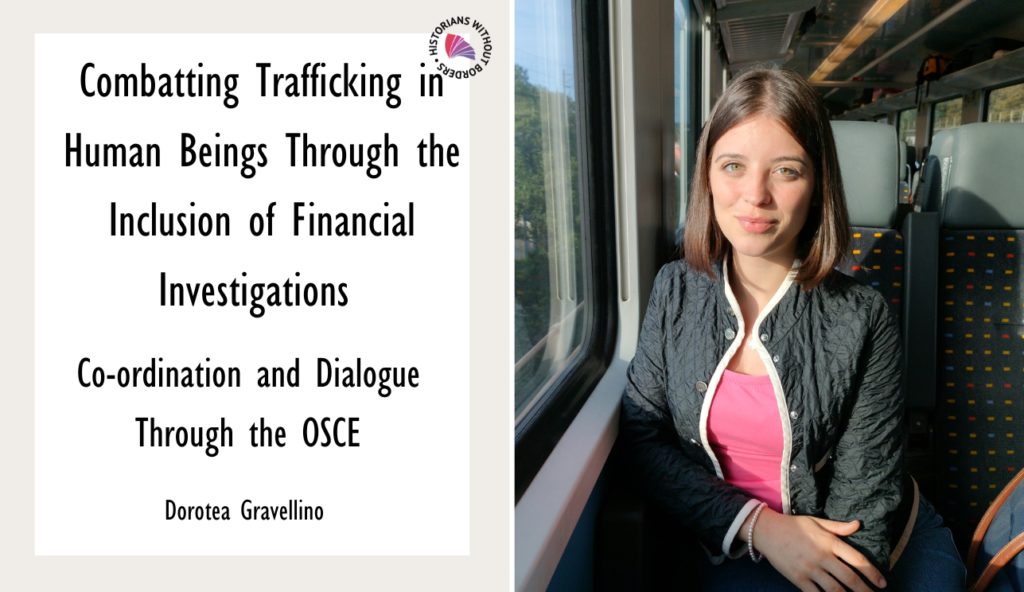As a final section of the OSCE by All project, Historians without Borders in Finland has curated a student policy-recommendation paper series in support of the 2025 Finnish Chairpersonship. The series looks at the OSCE’s added value in the European security architecture, as well as Finland’s engagement with the OSCE. The third paper in the series is written by Dorotea Gravellino.
The article can be downloaded as a pdf document through the button below. Endnotes are marked in the document.
Combatting Trafficking in Human Beings Through the Inclusion of Financial Investigations
Co-ordination and Dialogue Through the OSCE
Dorotea Gravellino
Policy Recommendations:
Combatting Human Trafficking highlights the value of the Organization for Security and Co-operation in Europe’s (OSCE) comprehensive approach to security and how it has developed over the past 20+ years. In maintaining the OSCE’s added value on this issue, Finland as OSCE Chairperson in 2025 could:
- Increase the involvement of the OSCE Parliamentary Assembly (PA) in improving policy coordination in OSCE participating States on trafficking of human beings and anti-money laundering measures.
- Develop an online portal to share best practices between participating States and foster policy coordination to combat human trafficking, building off EU efforts.
- Assist participating States in building capacity to combat trafficking of human beings by sponsoring more simulation-based trainings involving national law enforcement agencies as well as national-based and international financial institutions.
- Foster coordination with participating States when drafting their National Risk Assessments, to encourage the inclusion of anti-trafficking measurements.
Trafficking in human beings (THB) is a growing concern for the global community, including the European region. The UN regards THB as “one of the most lucrative illicit businesses in Europe,” with annual illegal profits reaching $3 billion.i According to Eurostat, in 2022, 10 093 people were registered as victims of THB in the European Union (EU).ii The EU Commission considers the true number to be “significantly higher” and the highest yearly rate since 2013.iii
The Organization for Security and Co-operation in Europe (OSCE) supports an intersectional approach to combatting human trafficking, which enables investigators and participating States to develop comprehensive tools to tackle this growing issue. As such, this paper draws attention to the OSCE’s work on combatting trafficking in human beings and the organization’s focus on connecting THB to anti-money laundry (AML) operations.
Finland has proven to be a forerunner in combatting human trafficking and has received praise from the OSCE Special Representative and Co-ordinator for Combatting Trafficking in Human Beings Dr. Kari Johnstone. Finland’s strong policy structures connecting different actors, such as the National Anti-Trafficking Coordinator and an independent National Rapporteur, are highlighted in addressing THB as a multidimensional security issue.iv This approach supports inclusive policy planning and Finland’s commitment to societal resilience.v
In light of Finland’s 2025 Chairpersonship priorities and the country’s stance towards the issue, it is encouraged to continue to develop the OSCE’s added value in combatting trafficking in human beings and money laundering. This could be done by sponsoring topical seminars with the OSCE Parliamentary Assembly, developing an online portal to share best practices, increasing the number of simulation-based trainings – a method pioneered by the OSCE, and increasing OSCE support for participating States when drafting National Risk Assessments. These recommendations can further develop resilient societies across Eurasia and maintain OSCE expertise on this policy issue.vi
Follow the money: The OSCE’s approach to combatting trafficking in human beings
From the start, the OSCE has represented an innovative approach to security, referred to as comprehensive security. Over the past 22 years, comprehensive security has also framed the fight against trafficking in human beings.
In 2003, the Special Representative and Co-ordinator for Combatting Trafficking in Human Beings was established by the OSCE. Trafficking in human beings is an important example of the multidimensional security threats that the OSCE attempts to address as it is connected with the rule of law, corruption, inequality, economic deprivation, climate change, and migration.vii Identifying THB as a multidimensional crime enables policymakers to better address key issues such as financial interests and money-laundering activities that allow THB to sustain. As such, in the 2013 Addendum to the OSCE Action Plan to Combat Trafficking in Human Beings, participating States agreed on “promoting the use of financial investigations linked with THB-related offences” via national anti-money-laundering authorities to better identify financial activities connected to THB.viii
Financial investigations are important tools for dismantling trafficking networks as they bridge the public and private sectors and help break THB business models. Subsequently, in 2019 the OSCE Office of the Special Representative and Co-ordinator for Combatting Trafficking in Human Beings presented Following the money.ix This was the first step-by-step guide to include insights and findings inferred from financial investigations into anti-human trafficking strategies. The OSCE advocates an improved dialogue between financial institutions and law enforcement. This encourages participating States to establish partnerships across the public and private sectors and the allocation of resources towards experts’ training and societal awareness. Transparency in operations and sourcing for funds is also emphasised. Finland pays due attention to this with regards to clarity on amounts of financing, timeline of work, and responsible funding agencies.x
As the OSCE has developed its approach to THB over the past 20 years, the organization increasingly emphasizes co-operation with external partners to advocate financial investigations in combatting THB. For example, the OSCE supports the annual meetings of the National Anti-Trafficking Co-ordinators and Rapporteurs, co-sponsored with the Council of Europe; the Alliance against Trafficking in Persons conference in co-operation with the office of the EU Anti-Trafficking Coordinator;xi and the Financial Intelligence against Human Trafficking project brought forth with Money Laundering Reporting Office of Switzerland (MROS).xii
Looking ahead: Recommendations and added value
The OSCE’s inclusion of financial investigations in combatting THB provides innovative tools for threat management and addressing the roots of human trafficking. The following recommendations can continue to develop the OSCE’s unique approach.
First, conferences, topical seminars, or side events at OSCE Parliamentary Assembly (PA) meetings can improve inter-parliamentary collaboration on the inclusion of financial investigations in anti-trafficking initiatives. This would build off initiatives such as a side event from the 2024 OSCE PA Annual Session titled Legislative action to prevent the misuse of technology for trafficking in human beings.xiii Finnish Parliamentarian Pia Kauma as President of the OSCE PA is perfectly positioned to promote these initiatives, as well as Finland’s legislative progress on this issue.
Second, an online portal, through which participating States could exchange opinions and queries on the use of financial intelligence in combatting THB, should be further investigated. This could increase cooperation and dialogue among OSCE participating States in developing anti-THB policy and further allow information sharing and exchange of best practices. While the EU Commission has developed a similar “anti-trafficking hub” for Member States, a complementary OSCE portal would offer a platform to strengthen anti-human trafficking co-operation from Vancouver to Vladivostok, further addressing the global nature of THB.xiv
Third, the number of specialized joint simulation-based trainings between law enforcement and financial institutions should be increased. This would allow for the strengthening of public/private partnerships and build off already extensive EU training and coordination. The OSCE Office of the Special Representative and Co-ordinator for Combatting Trafficking in Human Beings “has been a pioneer” in developing this multidimensional, joint simulation-based training approach to combatting human trafficking. Exploring ways to develop and finance this model with EU, UN, and national partners should be reflected on.xv
Fourth, the inclusion of anti-trafficking measures in participating States’ National Risk Assessments should be encouraged. The Strategic Analysis Report on Human Trafficking in Cyprus, put forth by the OSCE Special Representative and Co-ordinator for Combatting Trafficking in Human Beings in collaboration with the Cyprus Financial Intelligence Unit, could be a useful example.xvi
In conclusion, the Finnish Chairpersonship for 2025 has the potential to further increase the OSCE’s added value in combatting trafficking in human beings throughout the OSCE region and beyond. The OSCE’s innovative approach to security has allowed for the improvement of tools to combat this threat by fostering interconnectedness between different international institutions as well as national actors. The inclusion of financial investigations in combatting THB efforts highlights this progress. Connecting and improving these best practices among EU as well as Eurasian OSCE participating States is indeed an added value of the OSCE that should be preserved and developed.

Dorotea Gravellino is a master’s student in Peace, Mediation, and Conflict Research at Tampere University. In 2024 Dorotea graduated from the University of Bologna with a B.A. in International Relations and Diplomatic Affairs. In her previous studies, she focused on the phenomena of political violence and terrorism. Building on this work, Dorotea now explores the nexus between conflict and transnational criminal networks. Furthermore, she is keen on researching how this interconnection can be best integrated into the discourse on conflict transformation and peace mediation.
This report represents the views of the authors and does not reflect the institutional position of Historians without Borders in Finland.
This series of articles was produced as part of the OSCE by All project in cooperation with the Tampere Peace Research Institute, the University of Turku, the University of Helsinki, and the Finnish Ministry of Foreign Affairs.


